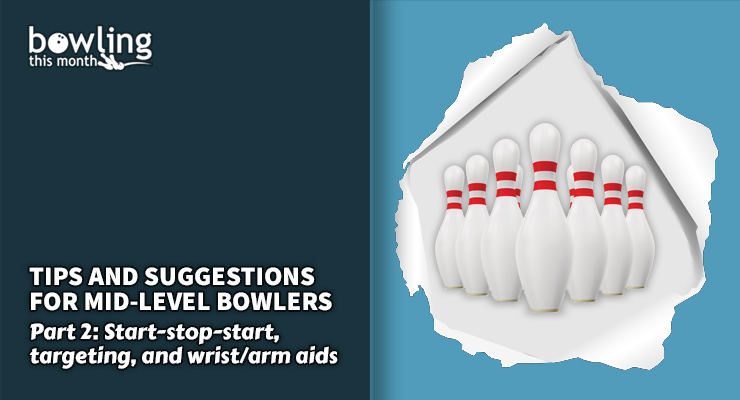Article Contents
- 1. Start-stop-start
- 2. Targeting
- 2.1. The value of targeting
- 2.2. What to target
- 3. Wrist aids
- 4. Hand and arm aids
- 5. Conclusion
Note: This article is only available to Bowling This Month subscribers.
In my last article, I discussed the concept of setup consistency and the importance of coaching. With that in mind, let’s continue with more tips for mid-level bowlers. Remember, for the purpose of this article, a mid-level or intermediate bowler is between a 165 and 190 average, with a smooth approach and reliance on spare-shooting.
This month, we’ll discuss the perils of a start-stop-start approach, the importance of targeting, and the kind of wrist aids available to help achieve a more powerful release.
Start-stop-start
Something I see with quite a few mid-level bowlers is a start-stop-start approach. They take their first step (of a four-step approach), then stop for a half-second or so, then take their remaining three steps. This hesitation—this start-stop-start—is a perfect way to ruin an otherwise good approach, because it turns a four-step approach into a three-step, but without any corresponding timing adjustment.
I break down the four-step approach into what I call The Rule of Fours, where each step has a corresponding upper-body motion. The bowler starts with most of the ball’s weight supported by the opposite arm, and a loose grip on the ball—definitely not a “hard squeeze.”
- Step one: Push the ball out. The opposite arm is still supporting the weight of the ball. When the pushaway is complete, gravity and momentum take over, then…
- Step two: Allow the ball to swing down.
- Step three: Allow the ball to swing back.
- Step four (slide): Allow the ball to swing forward.
The key word here is allow. In a perfect world, the bowler takes that first step and pushes the ball out, away from his body, at precisely the same time. At that point I tell my students, “Your work is finished.” The reason I say that is because, after that first step has been completed, gravity and momentum take over. After that first step, the bowler is pretty much along for the ride, allowing the ball to swing freely from the shoulder as he walks. The ball will, in effect, weigh nothing.
But think about what happens if there is any hesitation between the first and second steps. Rather than the ball swinging freely and weighing (effectively) nothing—there’s that gravity and momentum thing again—the weight of the ball suddenly shifts to the entire bowling arm because, by stopping, the bowler’s free armswing has stopped. In other words, muscle takes over and the bowler has to restart his approach ...
Already a premium member? Click here to log in.


